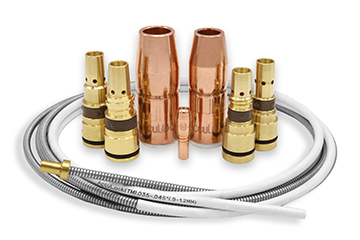Ways to Get the Most Out of Your MIG Gun Consumables
Although MIG gun consumables may seem like small part in the welding process, they can have a big impact. In fact, how well a welding operator selects and maintains these consumables can determine how productive and effective the welding operation is — and how long the consumables last.

Below are a few best practices that every welding operator should know when it comes to choosing and maintaining nozzles, contact tips, retaining heads and gas diffusers, and cable.
Nozzles
Because nozzles direct the shielding gas to the weld pool to protect it from atmospheric contamination, it is critical that gas flow is unobstructed.
Nozzles should be cleaned as often as possible — at least every other welding cycle in a robotic welding operation — to prevent spatter buildup can lead to poor gas shielding or cause short-circuiting between the contact tip and nozzle. Always ream nozzles and remove all spatter with the proper designed cutting blade to prevent damage to the nozzle and to avoid permanently altering it. Even when using a reamer or nozzle cleaning station, periodically inspect the nozzle for spatter adhesion, blocked gas ports and carburized contact surfaces before and after each use. Doing so is added protection to prevent poor gas flow that could affect weld quality.
Often, if spatter adheres to a nozzle, it means that nozzle’s life is over. Consider using a quick spray of anti-spatter solution at least every other reaming session. When using this liquid in conjunction with a reamer, be careful that the sprayer never sprays the insert, because the solution will deteriorate the ceramic compound or fiberglass inside the nozzle.
For high-temperature robotic welding applications, heavy-duty consumables are recommended. Keep in mind that, while brass nozzles often collect less spatter, they are also less heat resistant than copper. However, spatter more readily adheres to copper nozzles. Choose your nozzle compound according to the application — decide whether it’s more efficient to frequently change over bronze nozzles that burn out faster or consistently ream copper nozzles that last longer but collect more spatter.
Contact Tips and Gas Diffusers
Typically a contact tip wears out in one area or on one side first, depending on the welding cycle and how tight the| wire is. Using contact tips that can be rotated within the gas diffuser (or retaining head) can help extend the life of this consumable —and possibly even double its service life.
Always inspect contact tips and gas diffusers before and after each use to ensure all of the connections are in place and snug. When using an anti-spatter liquid, periodically check gas ports in the gas diffuser for blockage, and regularly inspect and replace the O-rings and metal retaining rings that hold the nozzle in place. Old rings can cause nozzles to fall down or shift positions at the point of connection to the gas diffuser.
Next, be sure all of the parts match. For example, when using a coarse threaded contact tip, make sure it is paired with a threaded diffuser that matches. If the robotic welding operation calls for a heavy-duty retaining head, be sure to pair it with heavy-duty contact tips.
Lastly, always select the proper diameter contact tip for the wire being used. Note, that some mild steel or stainless steel wire might call for a contact tip with a smaller inside diameter as compared to the wire size. Never hesitate to consult tech support or a sales person to determine which contact tip and gas diffuser combination will best suit the application.
Cables
Always check the torques of the body tube and end fittings regularly, as loose fitting cables can cause overheating and lead the robotic MIG gun to prematurely fail. Likewise, periodically check all cables and ground connections.
Avoid rough surfaces and sharp edges that can cause tears and nicks in the cable jacket; these can also cause the gun to prematurely fail. Never bend cables more than suggested by the manufacturer. In fact, sharp bends and loops in the cable should always be avoided. Often the best solution is to suspend the wire feeder from a boom or trolley, thereby eliminating a large number of bends and keeping the cable clear of hot weldments or other hazards that could lead to cuts or bends.
Also, never immerse the liner in cleaning solvents because it will corrode the cable and outer jacket, reducing the life expectancy of both. But do periodically blow it out with compressed air.
Finally use anti-seize on all threaded connections to ensure electricity transmission flows smoothly and everything all connections remain tight.
Remember, by selecting complementary consumable components and taking good care of them, it is not only possible maximize the efficiency and productivity of the robotic welding operation, but also it is possible to reduce downtime and increase profits.


